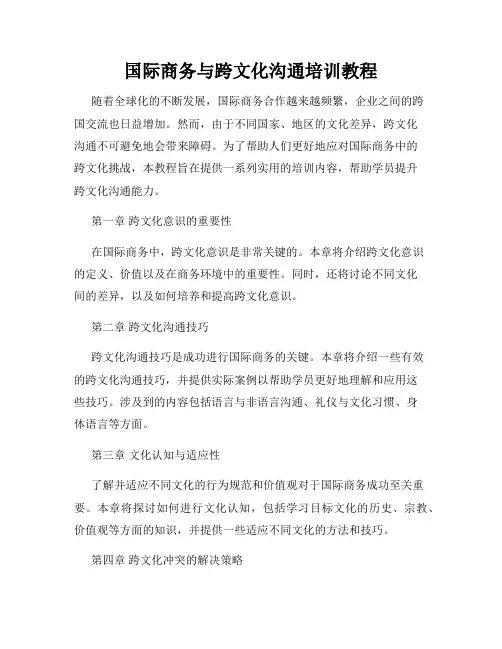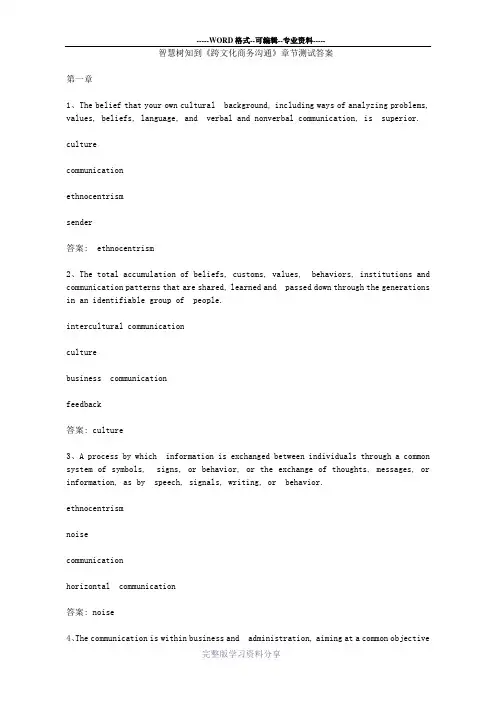跨文化商务沟通第01章复习过程
- 格式:ppt
- 大小:566.00 KB
- 文档页数:21









国际商务与跨文化沟通培训教程随着全球化的不断发展,国际商务合作越来越频繁,企业之间的跨国交流也日益增加。
然而,由于不同国家、地区的文化差异,跨文化沟通不可避免地会带来障碍。
为了帮助人们更好地应对国际商务中的跨文化挑战,本教程旨在提供一系列实用的培训内容,帮助学员提升跨文化沟通能力。
第一章跨文化意识的重要性在国际商务中,跨文化意识是非常关键的。
本章将介绍跨文化意识的定义、价值以及在商务环境中的重要性。
同时,还将讨论不同文化间的差异,以及如何培养和提高跨文化意识。
第二章跨文化沟通技巧跨文化沟通技巧是成功进行国际商务的关键。
本章将介绍一些有效的跨文化沟通技巧,并提供实际案例以帮助学员更好地理解和应用这些技巧。
涉及到的内容包括语言与非语言沟通、礼仪与文化习惯、身体语言等方面。
第三章文化认知与适应性了解并适应不同文化的行为规范和价值观对于国际商务成功至关重要。
本章将探讨如何进行文化认知,包括学习目标文化的历史、宗教、价值观等方面的知识,并提供一些适应不同文化的方法和技巧。
第四章跨文化冲突的解决策略跨文化冲突在国际商务中不可避免,有效地解决跨文化冲突对于保持商务关系的稳定十分重要。
本章将介绍常见的跨文化冲突类型,如观念差异、语言障碍、沟通误解等,并提供解决策略和实践经验供学员参考。
第五章跨文化团队管理在国际商务中,跨文化团队的管理能力直接关系到团队的协作和绩效。
本章将探讨如何构建和管理跨文化团队,包括团队成员配备、领导风格、决策模式等方面。
同时,还将介绍解决跨文化团队中的问题和挑战。
第六章跨文化谈判与合作跨文化谈判是国际商务中最常见的情景之一,谈判双方文化的差异往往会给谈判带来挑战。
本章将提供一些跨文化谈判的技巧和策略,并结合实际案例进行详细解析。
同时,还将介绍跨文化合作中的要点和注意事项。
结语本教程旨在帮助学员更好地应对国际商务与跨文化沟通中的挑战,提升自身的跨文化能力。
通过学习本教程,学员将能够更加敏锐地意识到跨文化问题的重要性,掌握跨文化沟通技巧,并有效解决跨文化冲突,从而在国际商务领域中取得更大的成功。
![2020智慧树,知到《跨文化商务沟通》章节测试[完整答案]](https://uimg.taocdn.com/33b8048e14791711cd791747.webp)
2020智慧树,知到《跨文化商务沟通》章节测试[完整答案]智慧树知到《跨文化商务沟通》章节测试答案见面课:冰山之下--商业广告中的文化价值观1、问题:Culture is like an iceberg. Only a small part of culture is visible. For instance, food, dress, paintings are all apparent to eyes. But a great part of culture is hidden under the water, such as _, , and so on.选项:A:viewsB:attitudesC:architectureD:customs答案: 【views;attitudes;customs】2、问题:Originally Geert Hofsted developed a model that identifies four primary cultural dimensions: _, , Individualism versus Collectivism, ___.选项:A:Power DistanceB:Long- versus Short-Term OrientationC:Uncertainty AvoidanceD:Masculinity versus Femininity答案: 【Power Distance;Uncertainty Avoidance;Masculinity versus Femininity】3、问题:Chinese consumers can be ascribed to the values of conformity and“face”.选项:A:对B:错答案: 【对】4、问题:It”s better for advertisers to realize and take note of the different cultural values and make corresponding adjustments to their advertising appeals.选项:A:对B:错答案: 【对】5、问题:The Americans have the spirit of innovation and risk-taking. They are not willing to cope with uncertainties inherent in life and can tolerate and accept new ideas and strangers.选项:A:对B:错答案: 【错】见面课:商业宣讲实践1、问题:In the presentation of GTech, the first part is to introduce some basic information about GTech.选项:A:对B:错答案: 【错】2、问题:PPT with paragraphs of text significantly decreases the attention of the audience.选项:A:对B:错答案: 【对】3、问题:Keeping your hands in your pockets during the presentation shows your confidence.选项:A:对B:错答案: 【错】4、问题:Images in PPT can distract people”s attention andmake the message less powerful.选项:A:对B:错答案: 【错】5、问题:A subtle nod, smile or placement of your hands can drastically change the meaning of your words.选项:A:对B:错答案: 【对】6、问题:What is the most obvious difference among informative presentation, persuasive presentation, and goodwill presentation? ( )选项:A:the audienceB:the informationC:the purposeD:the language答案: 【the purpose】7、问题:GTech is a __ company ( )选项:A:foodB:technicalC:mediaD:consultative答案: 【food】8、问题:Which is NOT the need of Japanese hospitals on robot nurses? ( )选项:A:error-orientedB:integratedC:autonomousD:error-free答案: 【error-oriented】9、问题:Which can NOT help you identify your audience in preparing a business presentation? ( )选项:A: AgeB:AppearanceC:OccupationD:Interest答案: 【Appearance】10、问题:Which can NOT attract audience”s attention? ( )选项:A:Use a rising intonationB:Stress important wordsC:Use short sentences at the start of a pointD:Keep on talking答案: 【Keep on talking】见面课:跨文化商务谈判模拟1、问题:In some Asian cultures, such as in China and Japan, they will adapt the indirect approach.选项:A:对B:错答案: 【对】2、问题:To the successful negotiations, the two sides must first understand the cultural differences.选项:A:对B:错答案: 【对】3、问题:High-context cultures are relational, collectivist, intuitive, and contemplative.选项:A:对B:错答案: 【对】4、问题:Germans make it very clear about the prices, conditions and ways of acting.选项:A:对B:错答案: 【对】5、问题:According to the negotiating objectives, goals for negotiations can be included:desired goal, acceptable goal and bottom goal.选项:A:对B:错答案: 【对】6、问题:It is appropriate to use your right hand to exchange business cards in Indian cultures.选项:A:对B:错答案: 【对】7、问题:Saudis do require as much personal space as most Western cultures.选项:A:对B:错答案: 【错】8、问题:There should be no more than three colors in business formal attire for men.选项:A:对B:错答案: 【对】9、问题:In Finland, a gift is not expected on the first visit, but would be expected on a subsequent visit.选项:A:对B:错答案: 【对】见面课:障碍与沟通--跨文化商务案例分析1、问题:What are the reasons for the Toyota Recall Crisis?选项:A:The failure of the public relationsB:A culture of deferenceC:Employee”s LoyaltyD:Communication across cultures答案: 【The failure of the public relations;A culture of deference;Employee”s Loyalty;Communication across cultures】2、问题:When responding to consumer safety issues, the typical Japanese corporation”s response is __.选项:A:Minimization of the problemB:Reluctance to recall the productC:Criticize the team membersD:too little compassion and concern for customers 答案: 【Minimization of the problem;Reluctance to recall the product;too little compassion and concern for customers】3、问题:There are many ways of examining cultural differences and their impact on international management. Culture can affect ____.选项:A:technology transferB:managerial attitudesC:managerial ideologyD:business-government relations答案: 【technology transfer;managerial attitudes;managerial ideology;business-government relations】4、问题:How can the culture of a society directly affect management approaches?选项:A:centralized versus decentralized decision makingB:safety versus riskC:stability versus innovationD:individual versus organization loyalty答案: 【centralized versus decentralized decision making; safety versus risk;stability versus innovation】5、问题:Which statement in the following French culture is not right?选项:A:Social class is important and social interactions are affected by class stereotypes.B:The French may admire or be fascinated with people who disagree with them.C:The French are very status conscious, and they like to provide signs of their status.D:The French focus on good connections, which can result in lower costs for doing business.答案: 【The French focus on good connections, which can result in lower costs for doing business.】6、问题:Which factor needs to be considered when pursuing business in Brazil?选项:A:Physical contact is acceptable as a form of communication.B:Brazilians tend to trust others, so be sure to form a strong relationship before bringing up business issues.C:Appearance is very important, as it will reflect both you and your company.D:Patience is not important.答案: 【Physical contact is acceptable as a form of communication.;Appearance is very important, as it will reflect both you and your company.】第一章1、The belief that your own cultural background, including ways of analyzing problems, values, beliefs, language, and verbal and nonverbal communication, is superior.culturecommunicationethnocentrismsender答案: ethnocentrism2、The total accumulation of beliefs, customs, values, behaviors, institutions and communication patterns that are shared, learned and passed down through the generations in an identifiable group of people.intercultural communicationculturebusiness communicationfeedback答案: culture3、A process by which information is exchanged between individuals through a common system of symbols, signs, or behavior, or the exchange of thoughts, messages, or information, as by speech, signals, writing, or behavior.ethnocentrismnoisecommunicationhorizontal communication答案: noise4、The communication is within business and administration, aiming at a common objective and profits for both the individuals and organizations.lateral communicationethnocentrismbusiness communicationintercultural communication答案: business communication5、The communication at the same level in an organization. horizontal communicationethnocentrismbusiness communicationlateral communication答案: horizontal communication6、When culture is contrasted with nature, it can be defined as“ life way of a population” in its broad sense, meaning whatcharacterizes the particular way of life of a population.对错答案: 错7、Culture is all men”s medium; there is no aspect of human life that is not touched and altered by culture.对错答案: 对8、The culture shown in an onion consists of two levels;a level of norms and values, or an invisible level of resultant behavior or artifacts of some form.对错答案: 错9、Culture cannot be known without a study of communication, and communication can only be understood with an understanding of the culture it supports.对错答案: 对10、In the global village, neighbors communicate free oftroubles and difficulties.对错答案: 错11、With the integration of language into the fabric of culture, confusion and dysfunction would reign and the culture would fail.对错答案: 错第二章1、A good mastery of grammar of one language can guaranteea successful communication.对错答案: 错2、Long before writing was developed,we learned to speak first.对错答案: 对3、There should always be an attachment at the end of abusiness memo.对错答案: 错4、A recommendation report is to recommend something to others.对错答案: 错5、Which is not verbal communication?Chat with your leaders and colleaguesDiscuss an issue in a groupGreeting with a smileLeave a message答案: Greeting with a smile6、____ refers to anything that distorts the message the source encodes.NoiseMessageSourceContext答案: Noise7、It is a universal truth that language is by culture and in turn it __ culture.influenced, reflectsdisplayed, influencesdetermined, reflectsshaped, influences答案: influenced, reflects8、Why should we take notes during a business call?Listen attentivelyServes as a record to take follow-up actionReport on the call to someone elseReflect on the call答案: Listen attentively,Serves as a record to take follow-up action,Report on the call to someone else9、How can you identify your audience in preparing a business presentation?AgeAppearanceInterestOccupation答案: Age,Interest,Occupation10、Before making a business call, what kind of questionscan you reflect?Do you need to report to your boss?Do you need to get information?Do you want to sell something, or convince the person of an idea?Do you need to ask for the person”s help or support?答案: Do you need to get information?,Do you want to sell something, or convince the person of an idea?,Do you need to ask for the person”s help or support?第三章1、Nonverbal behavior reflects the speaker”s subconciousness.对错答案:A2、Depending on the culture,a smile can indicate joy and amusement, it can also indicate embarrassment.对错答案:A3、Posture is the position in which you hold your body when standing or sitting.对错答案:对4、Intimate distance is most common when friends, old classmates, acquaintances and relativestalk.对错答案:错5、People in __ cultures usually view silence as lack of communication and are generally ____ with it.low context uncomfortablehigh context uncomfortablelow context comfortablehigh context comfortable答案:low context uncomfortable6、Which of the following countries uses high-context language?CanadaGermanyJapanUnited States答案:Japan7、The function of nonverbal signs is sometimes indispensible. For example, placing your index finger to your lips as an alternative to saying“Please calm down so that I can speak” is a case of ____.complementingrepeatingcontradictingsubstituting答案:substituting8、Which statements are correct about nonverbalcommunication?Nonverbal behavior is easily controlledA smile sometimes doesn”t mean a sincere smileNonverbal behavior accounts for much of the meaning we derive from conversation.Nonverbal communication is more than the complement of verbal communication.答案:9、How does nonverbal behavior control the pace or flow of communication?Be silentGesture of stoppingClap handsRaise voice答案:Be silent Gesture of stopping Clap hands Raise voice 10、Which of the countries belong to individualistic culture?ItalyAmericaFranceGreece答案:Italy America France第四章1、Power distance is a conceptual was developed by Hofstede to describethe extent to which the less powerful members of organizations and institutions accept and expect that power is distributed unequallythe power of multinational organizationsthe power differential between developed and less developed countriesthe power difference between men and women答案:2、Hofstede”s _ index measures the extent to which the lesspowerful members of organizations and institutions (like the family) accept and expect that power is distributed unequally. value orientationcultural dimensionscultural valuespower distance答案:power distance3、These are the most significant studies of cultural values except ___.Hall's High- and Low- Context TheoryKluckhohn and Strodtbeck's five Value Orientations Fons Trompenars”s model of culture with seven dimensions Geert Hofstede's six Cultural Dimensions答案:Fons Trompenars”s model of culture with seven dimensions4、The opinion that everyone has a position and clearly defined privileges is____.a view of hierarchical structure of social relationship a view of group orientation of social relationshipa view of individual orientation structure of social relationshipnone of the above答案:a view of hierarchical structure of social relationship5、Low-context communication is characterized by explicit speaking.对错答案:对6、Chinese culture is high-context in comparison to western culture.对错答案:对7、Cultures with a large power distance are hierarchical cultures.对错答案:对8、At the core of uncertainty avoidance is the idea that the future is predictable.对错答案:错9、Power distance in Hofstede's cultural dimensions is roughly similar to the value Kluckhohn calls hierarchy.对错答案:错10、In a culture emphasizing masculinity, it is more possible for men to play a nurturing role.对错答案:错第五章1、Etiquette is simply showing respect for others.对错答案:错2、Etiquette refers to the guideline for knowing how to behave appropriately in all situations.对错答案:A3、Kiss greeting usually happen between two men in the United States.错答案:错4、It”s OK to write on someone”s business card.对错答案:B5、A handshake should be friendly or respectful gesture, not a show of physical strength. So we should not squeeze other”s hand too hard.对错答案:A6、Before a dish is served, napkins can be placed either on the plate or on the left of forks.对错答案:A7、You”re invited to a business dinner. When do you take your napkin from the table and place it on your lap?Open it immediately.Wait for the host to take his or her napkin before takingWait for the oldest person at the table to take his or hers. Wait for all the ladies to take theirs before taking yours if you are a gentle man.答案:Wait for the host to take his or her napkin before taking yours.8、Which of the following behavior is appropriate in a business dinner?Use the napkin to wipe your nose.Cut all the food in your plate into small pieces.Sip from the side of the spoon when eating soup.Use the knife with your right hand.答案:CD9、What are the benefits of humor in the workplace?Humor can reduce stress.Humor can block negative emotions.Humor can help people develop rapport with each other. Humor can help solve problems.答案:ABCD10、In many Asian countries, the way you treat someone”s business card is a reflection of:How serious you are about the outcome of the meeting.How much you respect them as a person.What you think of their country.company and title.答案:ABCD第六章1、In some high-context cultures, public display of emotions is a sign of immaturity and a potential cause of shame to the group.对错答案:A2、Whether an international business negotiation succeeds or not is not only determined by the strategies and skills used in formal negotiation, but also closely related to whether enough careful preparation has been made.对错答案:A3、In the opening phase, the atmosphere is the only factor we should consider.对错答案:错4、Bargaining strength refers to the degree of movement that is possible for each party with respect to individual issues on the agenda.对错答案:错5、In some Asian cultures, they will use communication to encourage harmony, preserve face, and develop ____ relationships.Short-termLong-termMiddle-termShort run答案:Long-term6、The purpose of bargaining is to settle the differences that stand in the way of an agreement. Settling the differences involves____.high-context and low-contextconcession andreappraisaladjustment and compromiseaims and objectives答案:adjustment and compromise7、The proposal should be based on a sound analysis of the buyer”s current situation, taking into account of ____ and ____ within which the transaction takes place.the commercial circumstances, the overall contextthe corporate credit, the bank accounting bookthe manager”s stability, the site selectionthe commercial invoice, the chief negotiator”s ability 答案:the commercial circumstances, the overall context 8、Differences in____, ____, and____ have a profound impact on how successfully the parties are able to negotiate or conduct business transactions.BehavingWays of thinkingManaging conflictHuman resources答案:9、The political system,____, and the counterpart may in some way determine the success or failure of the negotiation. The legal systemThe business systemThe financial systemInfrastructure and logistics system答案:ABCD10、The specific tasks of the opening phase are concluded: To explain the concrete issueTo create suitable atmosphereTo state proposal in opening phaseTodeclare for our intention答案:ABCD。

智慧树知到《跨文化商务沟通》章节测试答案第一章1、The belief that your own cultural background, including ways of analyzing problems, values, beliefs, language, and verbal and nonverbal communication, is superior.culturecommunicationethnocentrismsender答案: ethnocentrism2、The total accumulation of beliefs, customs, values, behaviors, institutions and communication patterns that are shared, learned and passed down through the generations in an identifiable group of people.intercultural communicationculturebusiness communicationfeedback答案: culture3、A process by which information is exchanged between individuals through a common system of symbols, signs, or behavior, or the exchange of thoughts, messages, or information, as by speech, signals, writing, or behavior.ethnocentrismnoisecommunicationhorizontal communication答案: noiseand profits for both the individuals and organizations.lateral communicationethnocentrismbusiness communicationintercultural communication答案: business communication5、The communication at the same level in an organization.horizontal communicationethnocentrismbusiness communicationlateral communication答案: horizontal communication6、When culture is contrasted with nature, it can be defined as “ life way of a population” in its broad sense, meaning what characterizes the particular way of life of a population.对错答案: 错7、Cul ture is all men’s medium; there is no aspect of human life that is not touched and altered by culture.对错答案: 对8、The culture shown in an onion consists of two levels; a level of norms and values, or an invisible level of resultant behavior or artifacts of some form.错答案: 错9、Culture cannot be known without a study of communication, and communication can only be understood with an understanding of the culture it supports.对错答案: 对10、In the global village, neighbors communicate free of troubles and difficulties.对错答案: 错11、With the integration of language into the fabric of culture, confusion and dysfunction would reign and the culture would fail.对错答案: 错第二章1、A good mastery of grammar of one language can guarantee a successful communication.对错答案: 错2、Long before writing was developed,we learned to speak first.对答案: 对3、There should always be an attachment at the end of a business memo.对错答案: 错4、A recommendation report is to recommend something to others.对错答案: 错5、Which is not verbal communication?Chat with your leaders and colleaguesDiscuss an issue in a groupGreeting with a smileLeave a message答案: Greeting with a smile6、____ refers to anything that distorts the message the source encodes.NoiseMessageSourceContext答案: Noise7、It is a universal truth that language is by culture and in turn it __ culture.influenced, reflectsdisplayed, influencesdetermined, reflectsshaped, influences答案: influenced, reflects8、Why should we take notes during a business call?Listen attentivelyServes as a record to take follow-up actionReport on the call to someone elseReflect on the call答案: Listen attentively,Serves as a record to take follow-up action,Report on the call to someone else9、How can you identify your audience in preparing a business presentation?AgeAppearanceInterestOccupation答案: Age,Interest,Occupation10、Before making a business call, what kind of questions can you reflect?Do you need to report to your boss?Do you need to get information?Do you want to sell something, or convince the person of an idea?Do you need to ask for the person’s help or support?person of an idea?,Do you need to ask for the person’s help or support?第三章1、Nonverbal behavior reflects the speaker’s subconciousness.对错答案:A2、Depending on the culture,a smile can indicate joy and amusement, it can also indicate embarrassment.对错答案:A3、Posture is the position in which you hold your body when standing or sitting.对错答案:对4、Intimate distance is most common when friends, old classmates, acquaintances and relativestalk.对错答案:错5、People in __ cultures usually view silence as lack of communication and are generally ____ with it.low context uncomfortablehigh context uncomfortablehigh context comfortable答案:low context uncomfortable6、Which of the following countries uses high-context language?CanadaGermanyJapanUnited States答案:Japan7、The function of nonverbal signs is sometimes indispensible. For example, placing your index finger to your lips as an alternative to saying “Please calm down so that I can speak” is a case of ____.complementingrepeatingcontradictingsubstituting答案:substituting8、Which statements are correct about nonverbalcommunication?Nonverbal behavior is easily controlledA smile sometimes doesn’t mean a sincere smileNonverbal behavior accounts for much of the meaning we derive from conversation.Nonverbal communication is more than the complement of verbal communication.答案:9、How does nonverbal behavior control the pace or flow of communication?Gesture of stoppingClap handsRaise voice答案:Be silent Gesture of stopping Clap hands Raise voice10、Which of the countries belong to individualistic culture?ItalyAmericaFranceGreece答案:Italy America France第四章1、Power distance is a conceptual was developed by Hofstede to describethe extent to which the less powerful members of organizations and institutions accept and expect that power is distributed unequallythe power of multinational organizationsthe power differential between developed and less developed countriesthe power difference between men and women答案:2、Hofstede’s _ index measures the extent to which the less powerful members of organizations and institutions (like the family) accept and expect that power is distributed unequally.value orientationcultural dimensionscultural valuespower distance答案:power distance3、These are the most significant studies of cultural values except ___.Hall's High- and Low- Context TheoryKluckhohn and Strodtbeck's five Value OrientationsFons Trompenars’s model of culture with seven dimensionsGeert Hofstede's six Cultural Dimensions答案:Fons Trompenars’s model of culture with seven dimensions4、The opinion that everyone has a position and clearly defined privileges is____.a view of hierarchical structure of social relationshipa view of group orientation of social relationshipa view of individual orientation structure of social relationshipnone of the above答案:a view of hierarchical structure of social relationship5、Low-context communication is characterized by explicit speaking.对错答案:对6、Chinese culture is high-context in comparison to western culture.对错答案:对7、Cultures with a large power distance are hierarchical cultures.对错答案:对8、At the core of uncertainty avoidance is the idea that the future is predictable.对错答案:错9、Power distance in Hofstede's cultural dimensions is roughly similar to the value Kluckhohn calls hierarchy.对错答案:错10、In a culture emphasizing masculinity, it is more possible for men to play a nurturing role.对错答案:错第五章1、Etiquette is simply showing respect for others.对错答案:错2、Etiquette refers to the guideline for knowing how to behave appropriately in all situations.错答案:A3、Kiss greeting usually happen between two men in the United States.对错答案:错4、It’s OK to write on someone’s business card.对错答案:B5、A handshake should be friendly or respectful gesture, not a show of physical strength. So we should not squeeze other’s hand too hard.对错答案:A6、Before a dish is served, napkins can be placed either on the plate or on the left of forks.对错答案:A7、You’re invited to a business dinner. When do you take your napkin from the table and place it on your lap?Open it immediately.Wait for the host to take his or her napkin before taking yours.Wait for the oldest person at the table to take his or hers.Wait for all the ladies to take theirs before taking yours if you are a gentle man.答案:Wait for the host to take his or her napkin before taking yours.8、Which of the following behavior is appropriate in a business dinner?Use the napkin to wipe your nose.Cut all the food in your plate into small pieces.Sip from the side of the spoon when eating soup.Use the knife with your right hand.答案:CD9、What are the benefits of humor in the workplace?Humor can reduce stress.Humor can block negative emotions.Humor can help people develop rapport with each other.Humor can help solve problems.答案:ABCD10、In many Asian countries, the way you treat someone’s business card is a reflection of:How serious you are about the outcome of the meeting.How much you respect them as a person.What you think of their country.company and title.答案:ABCD第六章and a potential cause of shame to the group.对错答案:A2、Whether an international business negotiation succeeds or not is not only determined by the strategies and skills used in formal negotiation, but also closely related to whether enough careful preparation has been made.对错答案:A3、In the opening phase, the atmosphere is the only factor we should consider.对错答案:错4、Bargaining strength refers to the degree of movement that is possible for each party with respect to individual issues on the agenda.对错答案:错5、In some Asian cultures, they will use communication to encourage harmony, preserve face, and develop ____ relationships.Short-termLong-termMiddle-termShort run答案:Long-term6、The purpose of bargaining is to settle the differences that stand in the way of an agreement. Settling the differences involves____.high-context and low-contextconcession andreappraisaladjustment and compromiseaims and objectives答案:adjustment and compromise7、The proposal should be based on a sound analysis of the buyer’s current situation, taking into account of ____ and ____ within which the transaction takes place.the commercial circumstances, the overall contextthe corporate credit, the bank accounting bookthe manager’s stability, the site selectionthe commercial invoice, the chief negotiator’s ability答案:the commercial circumstances, the overall context8、Differences in____, ____, and____ have a profound impact on how successfully the parties are able to negotiate or conduct business transactions.BehavingWays of thinkingManaging conflictHuman resources答案:9、The political system,____, and the counterpart may in some way determine the success or failure of the negotiation.The legal systemThe business systemThe financial systemInfrastructure and logistics system答案:ABCD10、The specific tasks of the opening phase are concluded: To explain the concrete issueTo create suitable atmosphereTo state proposal in opening phaseTodeclare for our intention。
Chapter 1: Communication:An intercultural Perspective 1、N eeds and purposes for communication(1)Maslow’s hierarchy of needs----------be suit of developed country The most basic at the bottom to the most refined at the peak of atriangle---------Physiological needs,such as food,shelter,and sex;Justabove that come the needs of safety like family ; then there are socialneeds for things like love and friendship ; these are followed by egoand esteem needs ,which are above us as individuals wantingself-respect,recognition,and even power;finally ,at the top of thetraingle comes the most sophidticated need----------forself-actulization.this is about self-fulfillment,about finding and beingoneself.(2)For developing countrys-------------10 itemsSurvival ---------rent a flat/shelter ; try to get helpCo-operation---------work with others ;social groupsPersonal needs(within survival)Relationships(love/belonging)PersuasionPowerSocial needsInformationMaking sense of the worldSelf-expression2、d efinition of communication(1)Communication simply refers to the process of sending and receiving messeges among people .-------限定于人(2)Communication is someone perceives behavior or its residue and attributes meaning to it,communication has taken place regardless of whether that behavior is concious or unconcious ,intentional or unintentional . --------------没有限定于人3、the scope and classification of communication(1)there are at least two or more peopleClassification:1) frist classification of communication-----five tapesA :human communicationB : animal communicationC : human – animal communicatiomE : machine-to – machine communicationF : human –machine communication2)the second classification of communication(2)There must be some contact between communicators.(3)There must to be a language shared by communicators.(4)An exchange of information has taken placeThere is often taken as a successful condition of communication .but there are various degrees of success in communication,ranging from complete success,partial success to failure.4、T he process of communicationa)components of communicationThe definition identifies eight key components of communicationwithin the framework of intentional communication:message, ,sender , receiver ,channel , noise , feedback,encoding and decoding.i.messege--------verbal and nonverbal--------carries ideas from oneperson to another.2)sender refers to the person who sends the message .While the receiveris the one who receiver the message. :in order to reduce the uncertaintyor misunderstandings,the sender should think from the receiver’s piontof view when composing the message ,Besides ,the role of sender andreceiver is always changing.3)Channel/Medium refers to the way for sending or receiving message.4)Niose refers to the disturbances along the communicationprocesses ,which may resultunintended message perceived by therecevier .such as environment5)Feedback refers to the reaction from the message receiver to themessage sender.6)Encoding refers to the reaction from the message into asignal;Decoding refers to the process of the receiver interpreting thesignal from the senger.Encoding:the process of collecting message,considered of socialhabits,culture,communications rule.Decoding :the process of collecting feedback.b) Models of communication1. The Linear Model (线性模型)What it basically says is 5Ws:Who A senderSay what Directs a MessageIn which channel Through some MediumTo whom To a receiverAnd with what effect With some effectWhat sender through what message through what channel to whatreceiver with what effectThe theory’s advantages and disadvantagesAdvantages:this is a vary popular model which has been usedby a lot of communication scholars(this is the earlest andstill most useful method);Disadvantage:①human communication involves many morethings. e.g:power relations,rolerelations.age and sex difference,feelings②there are no feesback in this model(itdon’t pay attention to the feedback.).2.The Circular Model(环形模型)The communication is two-way process and thar everyone is both a decoder and an encoder.This model focus on feedback.3)The Contextualized ModelContext refers to the idea that every act of communication must been happen in some sort of surroundings,and what it meant by this is actually quite complicated。
教案首页3. The Scope and Classification of Communication4. The Process of Communication1) A basic communication model consists of these components: the sender and receiver, the medium or channal, messages, noise, feedback, encoding and decoding.e.g. “That’s all for today. See you all next week.”I(sender) put into words(encoding) my meani ngs that “class is over”(messge) and speak the words(channel) in the hope that the words will be suitably understood(decoding) by the students(receiver).2) Models of Communication① Linear ModelAristotle --- speaker→speach→audience→effectOccasionLasswell --- 5-W modelWho say what in what channal to whom with what effect.② Contextualized ModelContext: the idea that every act of communication must happen in some sort of surroundings and what is meant by this is actually quite complicated. There is physical context, social context and cultural context.II. Business Communication1. Defining Business CommunicationBusiness communication is the exchange of oral, nonverbal, and written messages within (and across the boundaries of) a system of interrelated and interdependent people working to accomplish common tasks and goals.2. Internal and External Communication(1) Internal communication refers to the communication taking place within a given organization through such written or oral channels as memos, reports, proposals, meetings, oral presentations, speeches, and person-to-person and telephone conversationsInternal communication includes: downward/ upward/ horizontal communication.(2) External communication refers to the communication between the organization and the outside institutions and people---the general public, customers, vendors and other businesses, and government officials.3. Formal and Informal Communication(1) Formal communication which refers to such communicative activities as business letter, speech, talk, a product presentation and so on.(2) Informal communication, also called grapevine, exists in almost all organizations and at all levels. It has a small number of activists guiding and influencing the informal communication.Assignment:1. Preview Part 3.2. Review the terms and key points in this part.教案首页Warm-up ActivitiesLook at some pictures and try to identify what cultural differences are displayed. Left: Westerners Right: Chinesea. b.c. d.e. f.g. h.I. The Nature of Culture1. Definitions of Culture(1) Scholars give various definitions of culture from different perspectives. “Culture is the arts and other manifestation of human intellectual achievement regarded collectively.”-----Concise oxford Dictionary(2) Culture may be classified by three large categories of elements:-- Artifact (which include items ranging from arrowheads to hydrogen bombs, magic charms to electric lights, and chariots to jet planes)-- Concepts (which include such beliefs or value systems as right or wrong, God and man, ethnic, and the general meaning of life)-- Behavior (which refers to the actual practice of concepts or beliefs)(3) At the most rudimentary, culture consists of two levels: a level of values, or an invisible level and a visible level of resultant behavior or artifacts of some form.3. Characteristics of Culture•C ulture influences biological processes:e.g. Sneezing; food culture; sleeping ; giving birth•C ulture is transmitted from generation to generation:‐For cultures to exist and endure, they must ensure that their crucial messages and elements are passed on (through communication).‐Some of the behaviors a culture selects to pass on are universal and others are unique.‐Each individual is heir to a massive “library” of cultural information collected.•C ulture is selected:‐Each culture represents a limited choice of behavior patterns from the infinite patterns of human experience.‐What a culture selects to tell each succeeding generation is a reflection of what that culture deems important.‐The notion of selectivity suggests that cultures tend to separate one group from anther.•C ulture is ethnocentric:‐Ethnocentrism is a universal tendency for any people to put its own culture and society in a central position of priority and worth.‐It leads to a subjective evaluation of how another culture conducts its daily business.•C ultures are interrelated wholes:‐Cultures are coherent and logical systems.‐You touch a culture in one place and everything else is affected. –Hall (1977)•C ulture is subject to change:‐History abounds with examples of how cultures have changed because of laws, shifts in values, natural disasters, wars , etc.‐Technology promoted cultural change. (e.g. e-mail)‐Although cultures change, most change affects only the surface structure of the culture. The deep structure resists major alterations.•C ulture is like an iceberg:‐a greater part of culture is hidden under the water, such as views, attitudes, preference, love and hatred, customs and habits. They are out of our awareness, which makes the study of culture difficult. In order to trulyunderstand a culture, we must explore the behaviors below the waterline.•C ulture is like an onion:‐The skins of an onion - symbols that represent the most superficial and the easiest to perceive by an outsider and the least important to an insider.‐The second skin of the onion is heroes-the kind of people you worship.‐The third skin is rituals-collective activities that are considered socially essential within a culture.‐The core of culture-values, which are the deepest manifestation of culture and the most difficult to understand by an outsider.II. The Basics of Cultural Values1. Definition of Value(1) Oxford Dictionary: one’s principles or standards or one’s judgment of what is valuable or important in life.(2) Hofstede: values are a broad tendency to prefer certain states of affairs over others.(3) Kluckhohn: values are a conception, explicit or implicit, distinctive of an individual or characteristic of a group, of the desirable which influences the selection from available modes, means, and ends of action.2. Priorities of Cultural Values(1) Values can be divided into three types:•U niversal valuesUniversal values are values common to all people.e.g. a desire to live a happy life is a universal value, as everyone wants to live happily•C ultural-specific values•P eculiar expression or deviation of individuals within culture.These are aspects of subjective culture. So we say, although each of us has a unique set of individual values, there also are values that tend to permeate a culture. These are called cultural values. Therefore, values tend 10 bebroad-based, enduring, and relatively stable.(2) Priorities of ValuesValues can be classified as primary, secondary, and tertiary.What do you value most? How do your priorities influence your day-to-day activities, especially those relating to your business work'' Begin answering these questions by choosing from the following 20 values that are common to most international cultures, but their importance varies from culture to culture; (1) group harmony, (2) competition. (3) seniority, (4) cooperation, (5) privacy, (6)教案首页Warm-up ActivitiesLook at some pictures and try to identify what cultural differences are displayed. Left: Westerners Right: Chinesea. b.c. d.e. f.g. h.I. The Nature of Culture1. Definitions of Culture(1) Scholars give various definitions of culture from different perspectives. “Culture is the arts and other manifestation of human intellectual achievement regarded collectively.”-----Concise oxford Dictionary(2) Culture may be classified by three large categories of elements:-- Artifact (which include items ranging from arrowheads to hydrogen bombs, magic charms to electric lights, and chariots to jet planes)-- Concepts (which include such beliefs or value systems as right or wrong, God and man, ethnic, and the general meaning of life)-- Behavior (which refers to the actual practice of concepts or beliefs)(3) At the most rudimentary, culture consists of two levels: a level of values, or an invisible level and a visible level of resultant behavior or artifacts of some form.3. Characteristics of Culture•C ulture influences biological processes:e.g. Sneezing; food culture; sleeping ; giving birth•C ulture is transmitted from generation to generation:‐For cultures to exist and endure, they must ensure that their crucial messages and elements are passed on (through communication).‐Some of the behaviors a culture selects to pass on are universal and others are unique.‐Each individual is heir to a massive “library” of cultural information collected.•C ulture is selected:‐Each culture represents a limited choice of behavior patterns from the infinite patterns of human experience.‐What a culture selects to tell each succeeding generation is a reflection of what that culture deems important.‐The notion of selectivity suggests that cultures tend to separate one group from anther.•C ulture is ethnocentric:‐Ethnocentrism is a universal tendency for any people to put its own culture and society in a central position of priority and worth.‐It leads to a subjective evaluation of how another culture conducts its daily business.•C ultures are interrelated wholes:‐Cultures are coherent and logical systems.‐You touch a culture in one place and everything else is affected. –Hall (1977)•C ulture is subject to change:‐History abounds with examples of how cultures have changed because of laws, shifts in values, natural disasters, wars , etc.‐Technology promoted cultural change. (e.g. e-mail)‐Although cultures change, most change affects only the surface structure of the culture. The deep structure resists major alterations.•C ulture is like an iceberg:‐a greater part of culture is hidden under the water, such as views, attitudes, preference, love and hatred, customs and habits. They are out of our awareness, which makes the study of culture difficult. In order to trulyunderstand a culture, we must explore the behaviors below the waterline.•C ulture is like an onion:‐The skins of an onion - symbols that represent the most superficial and the easiest to perceive by an outsider and the least important to an insider.‐The second skin of the onion is heroes-the kind of people you worship.‐The third skin is rituals-collective activities that are considered socially essential within a culture.‐The core of culture-values, which are the deepest manifestation of culture and the most difficult to understand by an outsider.II. The Basics of Cultural Values1. Definition of Value(1) Oxford Dictionary: one’s principles or standards or one’s judgment of what is valuable or important in life.(2) Hofstede: values are a broad tendency to prefer certain states of affairs over others.(3) Kluckhohn: values are a conception, explicit or implicit, distinctive of an individual or characteristic of a group, of the desirable which influences the selection from available modes, means, and ends of action.2. Priorities of Cultural Values(1) Values can be divided into three types:•U niversal valuesUniversal values are values common to all people.e.g. a desire to live a happy life is a universal value, as everyone wants to live happily•C ultural-specific values•P eculiar expression or deviation of individuals within culture.These are aspects of subjective culture. So we say, although each of us has a unique set of individual values, there also are values that tend to permeate a culture. These are called cultural values. Therefore, values tend 10 bebroad-based, enduring, and relatively stable.(2) Priorities of ValuesValues can be classified as primary, secondary, and tertiary.What do you value most? How do your priorities influence your day-to-day activities, especially those relating to your business work'' Begin answering these questions by choosing from the following 20 values that are common to most international cultures, but their importance varies from culture to culture; (1) group harmony, (2) competition. (3) seniority, (4) cooperation, (5) privacy, (6)教案首页Warm-up ActivitiesLook at some pictures and try to identify what cultural differences are displayed. Left: Westerners Right: Chinesea. b.c. d.e. f.g. h.I. The Nature of Culture1. Definitions of Culture(1) Scholars give various definitions of culture from different perspectives. “Culture is the arts and other manifestation of human intellectual achievement regarded collectively.”-----Concise oxford Dictionary(2) Culture may be classified by three large categories of elements:-- Artifact (which include items ranging from arrowheads to hydrogen bombs, magic charms to electric lights, and chariots to jet planes)-- Concepts (which include such beliefs or value systems as right or wrong, God and man, ethnic, and the general meaning of life)-- Behavior (which refers to the actual practice of concepts or beliefs)(3) At the most rudimentary, culture consists of two levels: a level of values, or an invisible level and a visible level of resultant behavior or artifacts of some form.3. Characteristics of Culture•C ulture influences biological processes:e.g. Sneezing; food culture; sleeping ; giving birth•C ulture is transmitted from generation to generation:‐For cultures to exist and endure, they must ensure that their crucial messages and elements are passed on (through communication).‐Some of the behaviors a culture selects to pass on are universal and others are unique.‐Each individual is heir to a massive “library” of cultural information collected.•C ulture is selected:‐Each culture represents a limited choice of behavior patterns from the infinite patterns of human experience.‐What a culture selects to tell each succeeding generation is a reflection of what that culture deems important.‐The notion of selectivity suggests that cultures tend to separate one group from anther.•C ulture is ethnocentric:‐Ethnocentrism is a universal tendency for any people to put its own culture and society in a central position of priority and worth.‐It leads to a subjective evaluation of how another culture conducts its daily business.•C ultures are interrelated wholes:‐Cultures are coherent and logical systems.‐You touch a culture in one place and everything else is affected. –Hall (1977)•C ulture is subject to change:‐History abounds with examples of how cultures have changed because of laws, shifts in values, natural disasters, wars , etc.‐Technology promoted cultural change. (e.g. e-mail)‐Although cultures change, most change affects only the surface structure of the culture. The deep structure resists major alterations.•C ulture is like an iceberg:‐a greater part of culture is hidden under the water, such as views, attitudes, preference, love and hatred, customs and habits. They are out of our awareness, which makes the study of culture difficult. In order to trulyunderstand a culture, we must explore the behaviors below the waterline.•C ulture is like an onion:‐The skins of an onion - symbols that represent the most superficial and the easiest to perceive by an outsider and the least important to an insider.‐The second skin of the onion is heroes-the kind of people you worship.‐The third skin is rituals-collective activities that are considered socially essential within a culture.‐The core of culture-values, which are the deepest manifestation of culture and the most difficult to understand by an outsider.II. The Basics of Cultural Values1. Definition of Value(1) Oxford Dictionary: one’s principles or standards or one’s judgment of what is valuable or important in life.(2) Hofstede: values are a broad tendency to prefer certain states of affairs over others.(3) Kluckhohn: values are a conception, explicit or implicit, distinctive of an individual or characteristic of a group, of the desirable which influences the selection from available modes, means, and ends of action.2. Priorities of Cultural Values(1) Values can be divided into three types:•U niversal valuesUniversal values are values common to all people.e.g. a desire to live a happy life is a universal value, as everyone wants to live happily•C ultural-specific values•P eculiar expression or deviation of individuals within culture.These are aspects of subjective culture. So we say, although each of us has a unique set of individual values, there also are values that tend to permeate a culture. These are called cultural values. Therefore, values tend 10 bebroad-based, enduring, and relatively stable.(2) Priorities of ValuesValues can be classified as primary, secondary, and tertiary.What do you value most? How do your priorities influence your day-to-day activities, especially those relating to your business work'' Begin answering these questions by choosing from the following 20 values that are common to most international cultures, but their importance varies from culture to culture; (1) group harmony, (2) competition. (3) seniority, (4) cooperation, (5) privacy, (6)。
跨文化商务沟通教程跨文化商务沟通是一门博大精深的学问,能够有效地运用不同文化背景的优势达到良好的沟通效果,有助于提升企业文化水平。
本文将带领读者深入跨文化理论,探寻企业如何通过跨文化沟通提升绩效,帮助读者在跨文化交流中发掘潜力。
跨文化商务沟通教程在全球化的时代,跨文化的沟通变得越来越重要。
企业只有在这个场景下可以真正获得发展,而要在多文化的环境下取得成功,就必须掌握一系列的跨文化沟通技巧。
一、认识自己的文化1. 了解自己的文化:学习自己的文化习俗,了解自己的文化偏好及偏见。
2. 尊重他人的文化:尊重他人文化差异,充分了解彼此文化的差异,并学会如何处理这些差异。
3. 学会宽容:在跨文化沟通中,宽容是必备技能之一,要学会宽容、宽容和尊重彼此,并发扬文明之风。
二、学习客气语言1. 避免敏感话题:由于文化差异,在沟通中避免双方都比较敏感的话题,此外,也要尊重对方国家的宗教信仰和文化传统。
2. 清晰表达自己的意思:在跨文化沟通中,要使用最客气的语言,避免有误导性的话语,表述清楚,利于和谐沟通。
3. 保持正直的原则:在跨文化沟通中,应保持正直的原则,一概同样的态度来看待所有参与者,尊重公平,增进双方的信任。
三、充分准备1. 提前准备:跨文化差异会让人产生一定程度的沟通困难,所以应该提前准备,对对方文化背景有一定的了解,准备好相关的文化知识,以及提交的材料。
2. 明确目的:在沟通之前,要有清晰的目的,清楚的笔记,知道哪里开始,哪里结束,明确内容,能和清楚地表达出你的想法。
3. 收集相关资料:准备工作中应当收集文化、政治等相关资料,尤其要留心媒体报道,以此可以更好的了解他国的想法和观点,以增加沟通的有效性。
以上就是本文关于跨文化商务沟通教程的介绍,跨文化沟通总是伴随着种种挑战,而在这样的场景下,要想取得成功就必须有一定的技巧。
要想学习跨文化沟通的技巧,首先要了解自己的文化,尊重他人的文化,学会宽容,学习客气语言,提前准备,明确目的,收集相关的资料等。